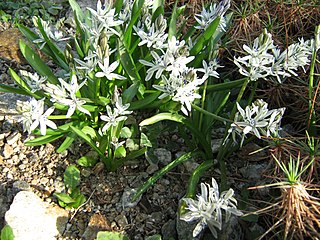
Ledebouria is a genus of African bulbous perennial herbs in the Asparagus family, Asparagaceae, subfamily Scilloideae. Most members were previously part of the genus Scilla. A number of species are grown by cacti and succulent enthusiasts for their patterned leaves.

Fessia is a genus of bulbous flowering plants in the family Asparagaceae, subfamily Scilloideae. It is distributed from Iran to Central Asia and Pakistan.

Seidlitzia a genus of flowering plants belonging to the family Amaranthaceae. It is also in the Salsoloideae subfamily.
Tamamschjanella is a genus of flowering plants belonging to the family Apiaceae.
Fortuynia is a monotypic genus of flowering plants belonging to the family Brassicaceae. It only contains one species, Fortuynia garcinii(Burm.f.) Shuttlew..
Ianhedgea is a monotypic genus of flowering plants belonging to the family Brassicaceae. The only species is Ianhedgea minutiflora.
Jaeschkea is a genus of flowering plants belonging to the family Gentianaceae.
Ducrosia is a genus of flowering plants belonging to the family Apiaceae.
Korshinskia is a genus of flowering plants belonging to the family Apiaceae. It is also in the Tribe Pleurospermeae.

Noaea is a genus of flowering plants belonging to the family Amaranthaceae. It is in the Salsoloideae subfamily.

Petrosimonia is a genus of flowering plants belonging to the family Amaranthaceae. It is also in the Salsoloideae tribe.
Stocksia is a monotypic genus of flowering plants belonging to the family Sapindaceae. It only contains one known species, Stocksia brahuicaBenth.
Sibbaldianthe is a genus of flowering plants belonging to the family Rosaceae. It is also in the Rosoideae subfamily.
Schweinfurthia is a genus of flowering plants belonging to the family Plantaginaceae. It is also in Tribe Antirrhineae.
Savignya is a monotypic genus of flowering plants belonging to the family Brassicaceae. It only contains one known species, Savignya parviflora(Delile) Webb
Parsana is a monotypic genus of flowering plants belonging to the family Urticaceae. It just contains one species, Parsana malekianaParsa & Maleki
Moriera is a monotypic genus of flowering plants belonging to the family Brassicaceae. It only contains one known species, Moriera spinosaBoiss.
Petiniotia is a monotypic genus of flowering plants belonging to the family Brassicaceae. It only contains one known species, Petiniotia purpurascens(Boiss.) J.Léonard
Stewartiella is a monotypic genus of flowering plants belonging to the family Apiaceae. According to Kew; it only contains one known species, Stewartiella crucifolia(Gilli) Hedge & Lamond
Lepechiniella is a genus of flowering plants belonging to the family Boraginaceae.




